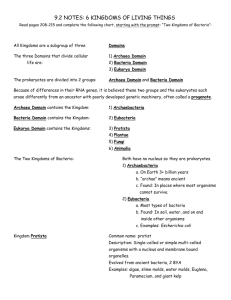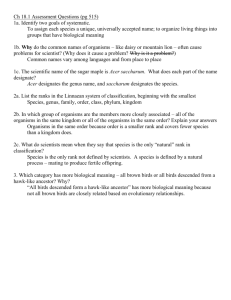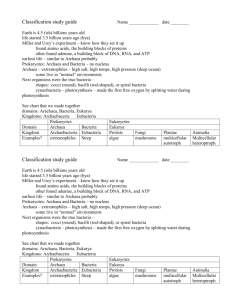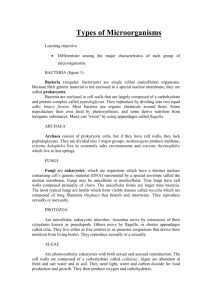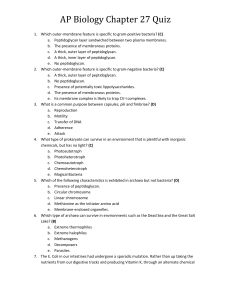UNIT 9 Study Guide Answer Key
advertisement
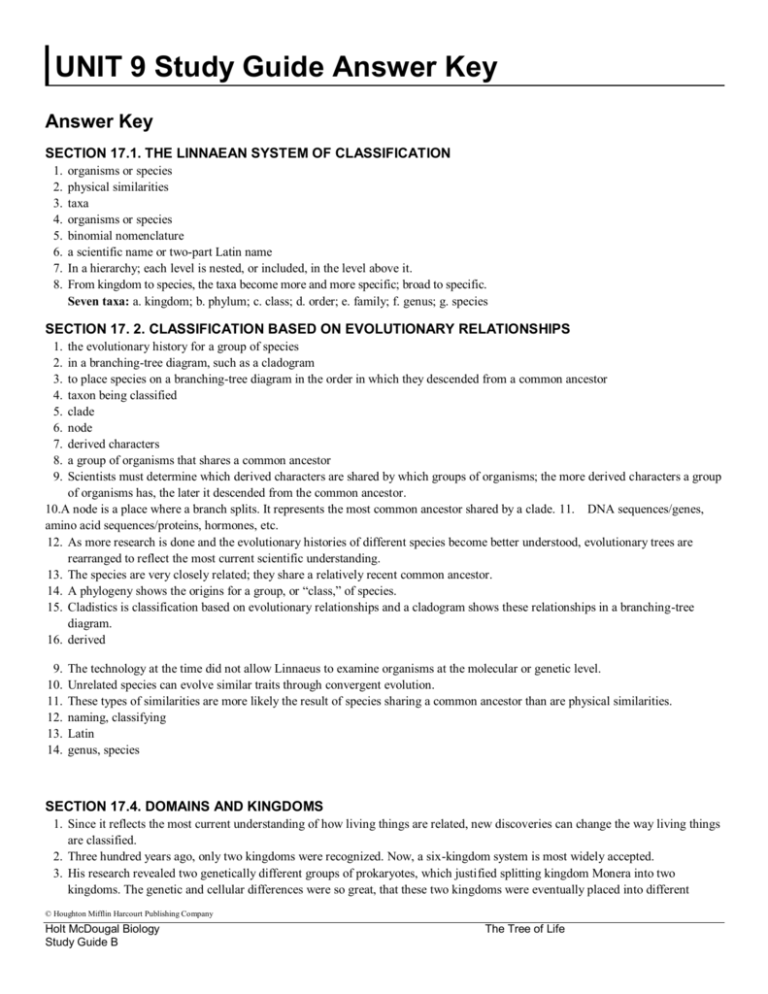
UNIT 9 Study Guide Answer Key Answer Key SECTION 17.1. THE LINNAEAN SYSTEM OF CLASSIFICATION 1. 2. 3. 4. 5. 6. 7. 8. organisms or species physical similarities taxa organisms or species binomial nomenclature a scientific name or two-part Latin name In a hierarchy; each level is nested, or included, in the level above it. From kingdom to species, the taxa become more and more specific; broad to specific. Seven taxa: a. kingdom; b. phylum; c. class; d. order; e. family; f. genus; g. species SECTION 17. 2. CLASSIFICATION BASED ON EVOLUTIONARY RELATIONSHIPS 1. 2. 3. 4. 5. 6. 7. 8. 9. the evolutionary history for a group of species in a branching-tree diagram, such as a cladogram to place species on a branching-tree diagram in the order in which they descended from a common ancestor taxon being classified clade node derived characters a group of organisms that shares a common ancestor Scientists must determine which derived characters are shared by which groups of organisms; the more derived characters a group of organisms has, the later it descended from the common ancestor. 10.A node is a place where a branch splits. It represents the most common ancestor shared by a clade. 11. DNA sequences/genes, amino acid sequences/proteins, hormones, etc. 12. As more research is done and the evolutionary histories of different species become better understood, evolutionary trees are rearranged to reflect the most current scientific understanding. 13. The species are very closely related; they share a relatively recent common ancestor. 14. A phylogeny shows the origins for a group, or “class,” of species. 15. Cladistics is classification based on evolutionary relationships and a cladogram shows these relationships in a branching-tree diagram. 16. derived 9. 10. 11. 12. 13. 14. The technology at the time did not allow Linnaeus to examine organisms at the molecular or genetic level. Unrelated species can evolve similar traits through convergent evolution. These types of similarities are more likely the result of species sharing a common ancestor than are physical similarities. naming, classifying Latin genus, species SECTION 17.4. DOMAINS AND KINGDOMS 1. Since it reflects the most current understanding of how living things are related, new discoveries can change the way living things are classified. 2. Three hundred years ago, only two kingdoms were recognized. Now, a six-kingdom system is most widely accepted. 3. His research revealed two genetically different groups of prokaryotes, which justified splitting kingdom Monera into two kingdoms. The genetic and cellular differences were so great, that these two kingdoms were eventually placed into different © Houghton Mifflin Harcourt Publishing Company Holt McDougal Biology Study Guide B The Tree of Life domains in the current three-domain system. Timeline: 1753: Linnaeus introduced his two-kingdom system which included Plantae and Animalia; 1866: Kingdom Protista introduced by Haeckel; 1938: Kingdom Monera introduced by Copeland; 1959: Kingdom Fungi introduced by Whittaker; 1977: Kingdom Monera split into kingdoms Bacteria and Archaea by Woese. 4. Bacteria: single-celled prokaryotes classified by shape, need for oxygen, and whether they cause disease; kingdom Bacteria. 5. Archaea: single-celled prokaryotes genetically distinct from bacteria, with different cell wall characteristics, many able to thrive in extreme environments; kingdom Archaea. 6. Eukarya: eukaryotes (distinct nucleus and membrane-bound organelles) that may be unicellular, colonial, or multicellular; kingdoms Protista, Fungi, Plantae, and Animalia. 7. Many bacteria and archaea are able to transfer genes among themselves outside of typical reproduction. This blurs the line between species as they are defined in the Linnaean system. 8. Eukarya 9. Archaea 10. Bacteria SECTION18.1. STUDYING VIRUSES AND PROKARYOTES 1. respond to their environment, have genes, can be infectious, are single-celled microorganisms, can reproduce on their own, classified in Linnaean system. 2. respond to their environment, have genes, are made only of a strand of DNA or RNA and a protein coat, can reproduce, but cannot reproduce on their own, small, not made of cells, not classified in Linnaean system, are infectious. 3. respond to their environment, have genes, can cause infection 4. Abilities to reproduce, use nutrients and energy, grow and develop, and to respond to the environment. 5. Virus: made of a strand of RNA or DNA and a protein coat, 50–200 nm. Viroid: made of strand of RNA, no protein coat, 50–150 nm, can cause disease in plants, cause infection through seeds or pollen. Prion: made of proteins that cause other proteins to misfold, no genetic material, 2–10 nm, incubate for a long time with no effect on host. 6. prion 7. pathogen 8. viroid 9. pathogen 10. prion 11. viroid 12. virus 13. virus SECTION 18.2. VIRAL STRUCTURE AND REPRODUCTION 1. 2. 3. 4. 5. Sketches should reflect spiky enveloped, helical, and polyhedral shapes of the influenza, rabies, and foot-and-mouth viruses. genetic material, capsid, lipid envelope infect living host cells by fitting its surface proteins to receptor molecules on the surface of the host cell They have long tails with spiky footlike fibers that help attach the virus to the host cell. The tail sheath can contract and the tail core punches through the cell wall, injecting the DNA like a syringe. 6. by endocytosis, entering the cells through vesicles made by the host cell; or by fusing with the plasma membrane of the host cell. 7. Lytic cycle, infectious pathway, detrimental to host, viral DNA is replicated, directs host to make viral parts, releases new viral particles, breaks apart (lyses) the host cell 8. Lysogenic cycle, infectious pathway, detrimental to host, viral DNA is replicated, forms a prophage or provirus, can remain as a © Houghton Mifflin Harcourt Publishing Company Holt McDougal Biology Study Guide B The Tree of Life 9. 10. 11. 12. 13. 14. permanent gene, does not destroy the host cell infectious pathways, detrimental to host, viral DNA is replicated bacteriophage prophage capsid lysogenic infection lytic infection SECTION 18.3. VIRAL DISEASES 1. 2. 3. 4. 5. 6. 7. 8. 9. 10. 11. 12. 13. 14. 15. the skin through cuts and scrapes, and through mucous membranes and body openings they use surface proteins that match the cell’s receptors cold viruses mutate easily, even from one person to another the surface proteins on the capsids of the influenza virus have a high mutation rate AIDS destroys the white blood cells of a person’s immune system. Vaccines are made from the same pathogen that they protect against. They are weakened versions or parts of the virus, that will cause the body to have an immune response. A vaccine prepares the host’s immune system for a future attack. retrovirus epidemic vaccine rabies West Nile chickenpox mumps hepatitis A SECTION 18.4. BACTERIA AND ARCHAEA 1. bacteria and archaea 2. marshes, the bottom of lakes, digestive tracts of herbivores. Y diagram: Bacteria—microscopic, single-celled, prokaryotes, have cell walls and membranes, move with flagella, diverse and widespread, 3 common shapes, flagella structurally different from archaea, cell walls and membranes chemically different from archaea. Archaea—microscopic, single-celled, prokaryotes, have cell walls and membranes, move with flagella, often live in extreme environments, many shapes, flagella structurally different from bacteria, cell walls and membranes chemically different from bacteria. Both— microscopic, single-celled, prokaryotes, have cell walls and membranes, move with flagella 3. A method of reproduction in prokaryotes, meaning “division by half.” © Houghton Mifflin Harcourt Publishing Company Holt McDougal Biology Study Guide B The Tree of Life 4. During conjugation, prokaryotes can exchange parts of their chromosomes through a hollow bridge of pili formed to connect two or more cells. 5. By forming an endospore. 6. A bacterium copies its chromosome and produces a wall around the copy. This thick wall around the bacterial DNA helps it survive harsh conditions. 7. facultative aerobe 8. flagellum 9. aerobe 10. endospore 11. conjugation 12. anaerobe 13. plasmid SECTION 18.5. BENEFICIAL ROLES OF PROKARYOTES 1. 2. 3. 4. 5. 6. They break down food, make vitamins and compounds, and fill niches that may otherwise be filled by disease-causing bacteria. They provide them with food and a home that has stable conditions. yogurt, cheeses, pickles, soy sauce, sauerkraut, vinegar photosynthesizing bacteria produce oxygen recycle carbon, nitrogen, hydrogen, and sulfur through the ecosystem convert atmospheric nitrogen into ammonia and other nitrogen compounds that plants can then use 7. in nodules on the roots of the plants 8. The bacteria capture nitrogen gas from the air trapped in the soil. They combine the nitrogen with hydrogen to produce ammonia that the plants can then use. 9. they can be used to clean up oil spills 10. the ability of bacteria to break down a material 11. some types of plastics are not biodegradable 12. Bioremediation is the use of living things, such as bacteria, to remove or neutralize contaminants such as polluted soil or water. SECTION 18.6. BACTERIAL DISEASES AND ANTIBIOTICS 1. by invading tissues and attacking cells, or by making toxins that are carried throughout the body by blood 2. because their immune system acts to defeat the infection without the infection ever causing symptoms 3. From foods contaminated by bacteria after they have been cooked and not refrigerated, or by eating foods that were contaminated with endospores and improperly canned. 4. Antibiotics work by affecting parts of bacterial cells that animal cells don’t have. Since viruses also do not have bacterial parts, they remain unaffected by antibiotics. 5. bacteria and fungi 6. Answers include: wash hands frequently, don’t eat foods that may have spoiled, don’t touch your nose or mouth 7. 8. 9. 10. 11. 12. 13. 14. 15. 16. Overuse: Answer should include natural selection in bacteria occurring through overexposure to antibiotics. Under use: Answer should include not killing the entire population of bacteria by not finishing the prescribed dose of antibiotic. Misuse: Answer should include using antibiotics for reasons other than treating illness. toxin antibiotic tetanus anthrax acne Lyme disease tooth decay © Houghton Mifflin Harcourt Publishing Company Holt McDougal Biology Study Guide B The Tree of Life


